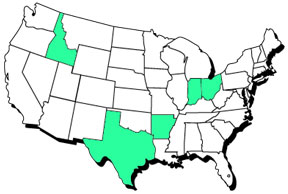 |
State Roundup

What you didn't hear on the nightly news: Cause of Cincinnati
unrest defined
 What
caused a major outbreak of rioting in the historic Riverfront
City of Cincinnati, the worst such eruption in the United States
in nearly a decade? Author Daniel Lazare in the Columbia Journalism
Review recently answered that question in the May/June 2001 issue.
Lazare's article, Cincinnati and the X-Factor, delves into the
answers. What
caused a major outbreak of rioting in the historic Riverfront
City of Cincinnati, the worst such eruption in the United States
in nearly a decade? Author Daniel Lazare in the Columbia Journalism
Review recently answered that question in the May/June 2001 issue.
Lazare's article, Cincinnati and the X-Factor, delves into the
answers.
The April 7th killing of an unarmed black teenager named Timothy
Thomas by a 27-year- old cop who, police officials claim, thought
Thomas was reaching for a gun was the spark that ignited a simmering
pool of racial unrest in the Cincinnati community called Over-the-Rhine.
No gun was found on the teenaged victim.
The uprising began soon after Timothy was shot. Following the
killing, the major media blamed rioting on "racial tension."
Only one paper, the Dayton Daily News, printed a story about
the initial spark for the rioting, and no other news sources
picked it up.
In Cincinnati and the X-Factor, Lazare condemns the lack of investigative
journalism. "Useful as such reporting may be, what was most
notable about Cincinnati riot coverage was the way it steered
determinedly clear of a development that is new, important, and
about as hard to miss as an elephant perched on a Chippendale
chair. This is the War on Drugs and the increasingly aggressive
policing it brings," Lazare wrote.
The Dayton Daily News reported in April, following the death
of Timothy Thomas, that for three years the city has been enforcing
a bizarre law that could get anyone arrested for drugs, even
suspicion of drug involvement, and banned from the neighborhood
for 90 days. Over-the-Rhine had been declared by city officials
to be a "drug exclusion zone." For three years the
community was under literal siege by the police, until January
2000 when a federal judge struck it down following a suit filed
by the ACLU of Ohio.
Called aggressive policing by officials, citizens complained
they were harassed incessantly by police. One citizen was stopped
and handcuffed some thirty times by police checking to see if
he had a "right" to be in the community. Mothers could
not see children, homeless people could not find shelter. Making
matters lethal, the police have shot and killed 15 black citizens
since 1994, and four have taken place since November 2000. Some
residents insist the police don't leave their cars without pulling
a gun.
"We got police video cameras on the corner watching people;
we got drug laws excluding them, and yet they have no effect
in fighting crime," said the Rev. Damon Lynch III. A Baptist
minister who heads the Cincinnati Black United Front, Lynch told
Lazare, "All these laws do is take away people's civil liberties."
Raymond Vasvari, legal director of the Ohio ACLU, maintains that
measures like the drug exclusion law are part of a tapestry of
abuses that's led to a culture of hostility between the African-American
community and the police. It's one more way that over-policing
has brought the community to the explosive brink.
Lazare concluded, "Cincinnati's drug and policing policies
are not an anomaly; they reflect the drug and policing policies
of the nation. If the War on Drugs is seen as a racially biased
and destructive invasion of Over-the-Rhine, then the United States
- not just Cincinnati - is moving backward, not forward. The
poorest and most vulnerable people are under constant pressure.
Since this is a good deal more disturbing than we care to admit,
conventional journalists look for all the ways that Cincinnati
is behind the times - and fail to notice the various ways in
which it may be leading. What's that about the dead canaries
in the mine? These journalists' conventional stories may be reassuring
to middle-class readers who never tire of being reminded how
enlightened and up-to-date they are. That is far from the truth,
however."
Daniel Lazare is the author, most recently, of America's Undeclared
War: What's Killing Our Cities and How We Can Stop It.
For additional online information: http://www.cjr.org/year/01/4/cincinnati.asp
Hard Feelings: Fatal Shootout in Marijuana Raid
Reverberates in an Idaho County
 On
January 3, Jerome County Sheriff Jim Weaver got a tip that Eden,
Idaho resident George Timothy Williams (known as Tim to his friends)
was a major marijuana dealer. Wasting no time, Weaver that evening
led a raid on Williams' residence. Within minutes, Williams and
two Jerome County sheriff's deputies, James Moulson and Phillip
Anderson, were dead, killed in a brief but furious firefight. On
January 3, Jerome County Sheriff Jim Weaver got a tip that Eden,
Idaho resident George Timothy Williams (known as Tim to his friends)
was a major marijuana dealer. Wasting no time, Weaver that evening
led a raid on Williams' residence. Within minutes, Williams and
two Jerome County sheriff's deputies, James Moulson and Phillip
Anderson, were dead, killed in a brief but furious firefight.
After the smoke cleared, police found four grams of marijuana
in the home of what they continue to describe as a "suspected
drug dealer."
"Tim was no drug dealer," Connie Chugg told DRCNet.
"He liked to smoke a joint and he would keep himself supplied,
but as for being a major drug dealer, that's absurd." Chugg
and her husband Curtis, who describe themselves as Williams'
"best friends," are still, six months after the event,
deeply disturbed by their friend's death at the hands of local
police.
They have reason to be disturbed. Williams was fingered by a
new girlfriend, Mary Ann Taylor, according to press reports,
but area residents familiar with Taylor, Williams and local law
enforcement draw a darker and more detailed picture. "Mary
Ann was a vulnerable woman," said one local resident who
declined to be named. "She had a history of mental problems
and drug problems and had already lost two children to the state.
When the sheriff's people talked to her, they threatened to take
away a third child if she did not provide information on drug
deals," the source told DRCNet. According to press accounts,
Taylor finally told sheriff's deputies she had observed a large
quantity of marijuana at Williams' residence the previous evening.
That was the basis for the fatal raid.
But other factors, also involving Mary Ann Taylor, were at play
as well. According to press accounts confirmed by local sources,
Taylor's former boyfriend had recently assaulted Williams in
an incident recorded by police, and Williams, fearing for his
physical safety, had armed himself. Friends of Williams also
say he was hearing impaired.
"I'm sure Tim didn't even know who was breaking down his
door," said Eden resident and Williams' friend Cindy Kopp.
"He didn't deserve to die that way, and neither did the
two young police officers who lost their lives."
The families of all three men killed in the raid have now filed
wrongful death claims naming the county, Sheriff Weaver and informant
Mary Ann Taylor, who has since vanished. The Williams family
has filed a $10 million claim, the family of Deputy Anderson
is asking for $5 million, and the family of Deputy Moulson seeks
$2.4 million.
In the Anderson family claim against the county and the sheriff,
attorneys wrote that Weaver acted on information from an informant
of "questionable reliability" to get the search warrant,
then added: "At the time the search warrant was obtained,
Sheriff Weaver and Jerome County officers/agents knew that Mr.
Williams had recently acquired several guns and armed himself
because of past acts of violence involving Mr. Douglas Norgard,
the ex-boyfriend of Ms. Taylor. Sheriff Weaver and Jerome County
officials also knew (or should have known) that Mr. Williams
was in fear for his life and was armed and dangerous." The
claim also asserts that Weaver sent his "youngest and most
inexperienced deputies" into Williams' home and that "by
knowing and intentionally ordering Phillip Anderson to enter
a dangerous and life-threatening situation, the Sheriff's office
is responsible for his death.
Supreme Court rules Arkansas drug sentence unconstitutional
 An
Arkansas state prison sentence has proven to be too much for
the 8th U.S. Circuit Court of Appeals. On July 9th, the appeals
court threw out a life sentence given to a 54-year-old first
offender caught in possession of $20 worth of cocaine. An
Arkansas state prison sentence has proven to be too much for
the 8th U.S. Circuit Court of Appeals. On July 9th, the appeals
court threw out a life sentence given to a 54-year-old first
offender caught in possession of $20 worth of cocaine.
Grover Henderson was sentenced in Lafayette County in 1994 for
possession of about a quarter-gram of cocaine. He had no prior
criminal record. Although he appealed, the Arkansas Supreme Court
upheld the sentence. The 8th Circuit disagreed. "This is
one of those rare cases in which the sentence imposed is so harsh
in comparison to the crime for which it was imposed that is unconstitutional,"
wrote the court, vacating the sentence and giving the state of
Arkansas 90 days in which to re-sentence Henderson or free him.
Although Henderson has already served seven years for his quarter-gram,
Lafayette County Prosecutor Brent Haltom told the Associated
Press he would recommend another sentencing offer. Haltom said
Henderson had previously rejected an 18-year sentence in return
for a guilty plea.
Referring to Henderson's choice to appeal his sentence, Haltom
generously commented, "We're not going to hold it against
him that he went through the legal system."
http://www.drcnet.org/wol/194.html#sentencingfollies
Texas Prisoners Can't Call Home
By Roger Hummel
 Most
people know jail and prison inmates have access to telephones
must make collect calls to talk with their loved ones on the
outside, or use a pre-paid calling system-except in Texas. The
163,000+ state prisoners in Texas are not now and never have
been allowed access to public telephones for outgoing calls,
collect or otherwise. Prison officials enforce 19th century rules
which forbid Texas prisoners to use public telephones. Most
people know jail and prison inmates have access to telephones
must make collect calls to talk with their loved ones on the
outside, or use a pre-paid calling system-except in Texas. The
163,000+ state prisoners in Texas are not now and never have
been allowed access to public telephones for outgoing calls,
collect or otherwise. Prison officials enforce 19th century rules
which forbid Texas prisoners to use public telephones.
In a rare flash of progressive thinking back in 1991, the State
Comptroller, John Sharp proposed installing public telephones
in Texas prisons. Sharp's plan would have allowed prisoners to
make overpriced collect-only calls with the excess revenue being
divided between the state and the communications company which
installed and operated the telephone system.
Sharp's plan was vetoed by prison administrators who felt that
allowing prisoners to make frequent calls, regardless of the
fact that doing so might generate income for the state, would
give prisoners more of an opportunity to plan crimes.
Currently, those Texas prisoners with trusty status who are classified
as "minimum custody" and who have a virtually spotless
disciplinary record are allowed to make one 5-minute collect
telephone call to one individual on his or her state-approved
Visitor List once every 90 days.
After submitting a written request to make a telephone cal and
receiving approval from prison officials, a prisoner is summoned
to the administration building during evening hours. After waiting
for an hour or more, the prisoner is ushered into a small room
occupied by a prison guard and two telephones. The guard dials
the number, ensures that the called party accepts the charges,
and then motions for the prisoner to pick up the second telephone.
The guard starts a 5-minute timer and listens to both sides of
the conversation with his finger on the receiver button to cut
off the call if he doesn't approve of what he hears. After 5
minutes, the guard terminates the call, often in mid-sentence.
In a March 2000 interview, Larry Todd, a Texas prison system
spokesman, said the system's current telephone practices are
not likely to change any time soon. "Presently, inmates
get a telephone call every 90 days," he said, adding that
prison officials would oppose a for-profit contract system. "We
are very satisfied with the current system."
As far as the concept of allowing prisoners to make direct calls
using a prepaid debit card system similar to those used in other
states, Todd said it is not likely. "The bookkeeping on
that is enormous," he said. "Right now we don't have
the staff to even implement such a program."
Constrained by a plantation-era mentality, Todd is surely unaware
of computers and their application to routine bookkeeping chores.
And, as with most other overpriced prison telephone systems,
the communication company's staff handles the implementation
and operation of such a program.
Todd also seems unaware that Texas is now spending millions of
taxpayers' dollars pursuing American Correctional Association
accreditation of its 100+ prisons and that ACA standards 3-4259
and 3-4439 require that prisoners be allowed access to public
telephones.
About the same time that Larry Todd granted his interview, Gary
Johnson, Director of the Institutional Division of the Texas
prison system, was a guest speaker at the 5000+ member Texas
Inmate Families Association meeting in Austin. When asked about
installing telephones for prisoners' use, Johnson answered, "We
are not ever considering adding this privilege." He noted
that "prison is not a good place to be and never will be."
Consequently, the prisoners confined to the largest prison system
in the United States have no access to public telephones and
the free world can rest easy because Texas prisoners won't have
more of an opportunity to plan crimes.
Two Steps Forward, One Step Back: Indiana Sentencing
 The
recently adjourned Indiana General Assembly showed increasing
signs of drug war fatigue this year as it passed into law measures
that will get nonviolent drug offenders out of prison faster
and make them ineligible for enhanced sentences under the state's
habitual offender law (known as "the bitch"). But in
the same session, it succumbed to the spreading methamphetamine
hysteria, passing a law that will heighten meth penalties to
bring them in line with those for cocaine and "narcotics." The
recently adjourned Indiana General Assembly showed increasing
signs of drug war fatigue this year as it passed into law measures
that will get nonviolent drug offenders out of prison faster
and make them ineligible for enhanced sentences under the state's
habitual offender law (known as "the bitch"). But in
the same session, it succumbed to the spreading methamphetamine
hysteria, passing a law that will heighten meth penalties to
bring them in line with those for cocaine and "narcotics."
Under Indiana law, trafficking in those drugs can bring a 20-year
prison sentence. For the first time, some persons convicted of
drug dealing offenses will be able to avoid prison by serving
home detention or work release sentences instead. Other drug
offenders will be eligible for earlier release under the state's
newly implemented Community Transition Program.
Rep. B. Patrick Bauer (D-South Bend) was a prime mover in the
sentencing reforms. Bauer wrote the community release and habitual
offender language and then inserted it into the state budget
bill, which became law earlier this month. In an interview with
the Fort Wayne Journal Gazette last week he sounded two themes:
the cost of incarceration and the need to consider drug treatment.
"Many of these prisoners are drug offenders who are not
dangerous to society. They are only dangerous to themselves,"
Bauer said. "We put them in prisons, which are known as
schools of crime, they come out hardened and two out of three
go back. We're trying to stem the tide of building prisons,"
he said. "It's a tax savings, but also perhaps we need to
focus more on rehabilitation," Bauer added.
More than 3,600 of Indiana's 20,000 prisoners are doing time
solely on drug charges, according to the Indiana Department of
Corrections. Each costs the state between $25,000 and $30,000
annually to imprison. Indiana also holds 73 prisoners convicted
only of drug offenses who have seen their sentences doubled under
the state's habitual offender laws. Under the old laws, a person
arrested for a felony charge could be charged as a habitual offender
if he had two prior unrelated felony convictions.
Possession of illegal drugs other than marijuana is a felony
in Indiana. The new habitual offender law, however, does not
allow prosecutors to bring the charge if the new offense is a
drug offense, if the previous felonies were drug offenses, and
no more than one of them was a drug distribution offense.
Allen County (Fort Wayne) Prosecutor Robert Gevers II told the
Journal Gazette his office used "the bitch" as a bargaining
tactic by promising defendants not to use it in return for a
guilty plea. He bemoaned the loss of leverage.
"We may end up filing fewer habitual offender charges, and
you won't see sentences as long as they could be," a glum
Gevers told the Fort Wayne newspaper before going on a brief
rant about a real drug war. "If in fact the country determined
that we were truly going to wage a war on drugs-as defined by
a dictionary and not this piecemeal, half-hearted approach-we
would not be having this conversation. It would be over,"
Gevers declaimed.
Allen County Superior Court Judge Kenneth Scheibenberger provided
the Journal Gazette with one example of the law's impact. He
sentenced Fort Wayne resident Alvin White to 20 years in prison
last year, and added another 20 under the habitual offender law.
White's prior convictions were for cocaine possession. Under
the new law, White would not have been eligible for the doubled
sentence.
Scheibenberger also hailed the new provision allowing persons
convicted of drug distribution to qualify for home detention
or work release. He told the newspaper the law would allow him
to make a distinction in sentencing between entrepreneurs and
addicts.
Not all legislators were in accord. "I don't agree that
someone should be able to bypass prison altogether dealing narcotics
at this level," Sen. David Long (R-Fort Wayne) told the
Indianapolis Star.
The legislature also provided for earlier release dates for drug
offenders. Under the state's Community Transition Program, nonviolent
offenders can be released into a supervised setting as the end
of their sentence draws near. Previously, prisoners had to be
within 60 or 120 days of completing their sentences; now drug
offenders need be only within six months. But the impact of this
move will be limited. Release is not automatic, and according
to the Journal Gazette, Allen County, in which judges have granted
early release to only 15% of those eligible, has one of the state's
highest participation rates.
Indiana lawmakers also took a step backward with the passage
of a new methamphetamine law. Under siege from law enforcement
and a sensation-seeking mass media-the Indianapolis Star editorialized
in April about "bracing for a methamphetamine epidemic"-the
solons voted to heighten meth possession, manufacture, and distribution
penalties to make them as tough as the state's penalties for
heroin and cocaine. The bill also makes it a crime to transport
or store the precursor chemicals used in meth's manufacture,
and increases criminal penalties for the theft of anhydrous ammonia,
widely used by farmers in fertilizers, but also widely used by
amateur meth cooks.
Indiana's schizophrenic approach to drug policy this year was
exemplified by the Indiana Prosecuting Attorneys Council, which
lobbies lawmakers on crime issues. The group could not arrive
at a consensus on the drug bills, Executive Director Steve Johnson
told the Journal Gazette. The group had "a slew of opinions"
but could not reach agreement, he said.
"There's a lot of consideration about the effectiveness
of the laws. Everyone is trying to figure out the best way to
handle this," Johnson said. "We are not waving the
white flag. States all over the country are just examining the
war on drugs."

|

